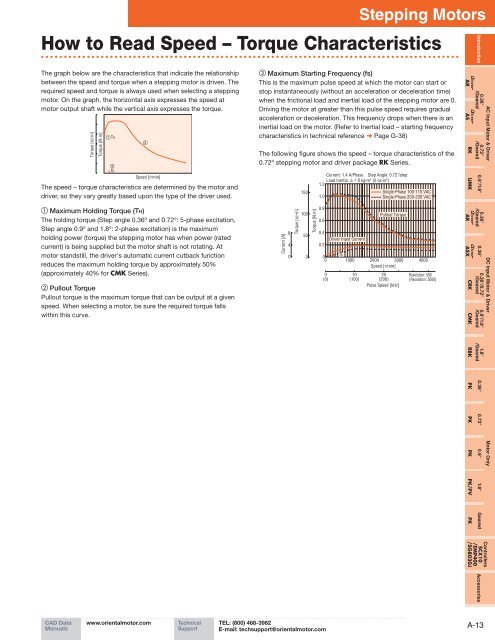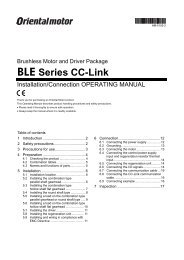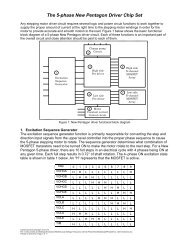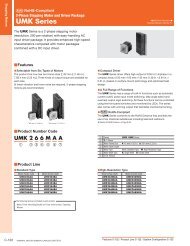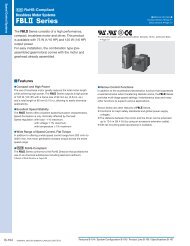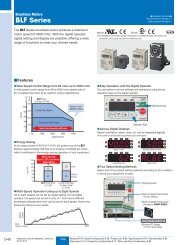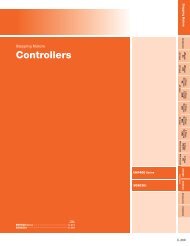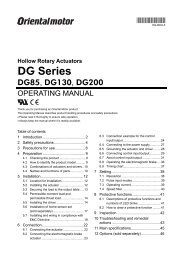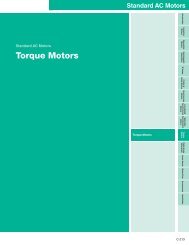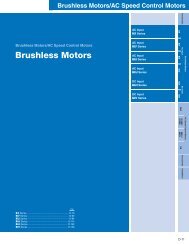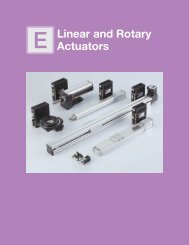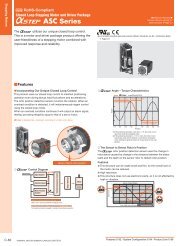A Stepping Motors - Oriental Motor
A Stepping Motors - Oriental Motor
A Stepping Motors - Oriental Motor
Create successful ePaper yourself
Turn your PDF publications into a flip-book with our unique Google optimized e-Paper software.
<strong>Stepping</strong> <strong><strong>Motor</strong>s</strong><br />
How to Read Speed – Torque Characteristics<br />
Introduction<br />
The graph below are the characteristics that indicate the relationship<br />
between the speed and torque when a stepping motor is driven. The<br />
required speed and torque is always used when selecting a stepping<br />
motor. On the graph, the horizontal axis expresses the speed at<br />
motor output shaft while the vertical axis expresses the torque.<br />
Torque [oz-in]<br />
Torque [N•m]<br />
1TH<br />
3<br />
fs<br />
Speed [r/min]<br />
The speed – torque characteristics are determined by the motor and<br />
driver, so they vary greatly based upon the type of the driver used.<br />
1 Maximum Holding Torque (TH)<br />
The holding torque (Step angle 0.36º and 0.72º: 5-phase excitation,<br />
Step angle 0.9º and 1.8º: 2-phase excitation) is the maximum<br />
holding power (torque) the stepping motor has when power (rated<br />
current) is being supplied but the motor shaft is not rotating. At<br />
motor standstill, the driver's automatic current cutback function<br />
reduces the maximum holding torque by approximately 50%<br />
(approximately 40% for CMK Series).<br />
2 Pullout Torque<br />
Pullout torque is the maximum torque that can be output at a given<br />
speed. When selecting a motor, be sure the required torque falls<br />
within this curve.<br />
2<br />
3 Maximum Starting Frequency (fs)<br />
This is the maximum pulse speed at which the motor can start or<br />
stop instantaneously (without an acceleration or deceleration time)<br />
when the frictional load and inertial load of the stepping motor are 0.<br />
Driving the motor at greater than this pulse speed requires gradual<br />
acceleration or deceleration. This frequency drops when there is an<br />
inertial load on the motor. (Refer to Inertial load – starting frequency<br />
characteristics in technical reference ➜ Page G-38)<br />
The following figure shows the speed – torque characteristics of the<br />
0.72º stepping motor and driver package RK Series.<br />
Current [A]<br />
8<br />
4<br />
0<br />
Torque [oz-in]<br />
150<br />
100<br />
50<br />
0<br />
Torque [N·m]<br />
Current: 1.4 A/Phase Step Angle: 0.72˚/step<br />
Load Inertia: JL = 0 kg·m 2 (0 oz-in 2 )<br />
1.2<br />
1.0<br />
0.8<br />
0.6<br />
0.4<br />
0.2<br />
0<br />
0<br />
0<br />
(0)<br />
Driver Input Current<br />
fs<br />
1000 2000 3000 4000<br />
Speed [r/min]<br />
10<br />
(100)<br />
Single-Phase 100-115 VAC<br />
Single-Phase 200-230 VAC<br />
Pullout Torque<br />
20<br />
(200)<br />
Pulse Speed [kHz]<br />
Resolution: 500<br />
(Resolution: 5000)<br />
AR AS<br />
RK UMK<br />
AR ASX<br />
CRK CMK RBK PK PK PK PK/PV PK<br />
0.36°<br />
/Geared<br />
0.72°<br />
/Geared<br />
0.9°/1.8°<br />
0.36°<br />
/Geared<br />
0.36°<br />
0.36°/0.72°<br />
/Geared<br />
0.9°/1.8°<br />
/Geared<br />
1.8°<br />
/Geared<br />
0.36° 0.72° 0.9° 1.8° Geared<br />
AC Input <strong>Motor</strong> & Driver DC Input <strong>Motor</strong> & Driver <strong>Motor</strong> Only<br />
Controllers<br />
SCX10<br />
/EMP400<br />
/SG8030J<br />
Accessories<br />
CAD Data<br />
Manuals<br />
www.orientalmotor.com<br />
Technical<br />
Support<br />
TEL: (800) 468-3982<br />
E-mail: techsupport@orientalmotor.com<br />
A-13


